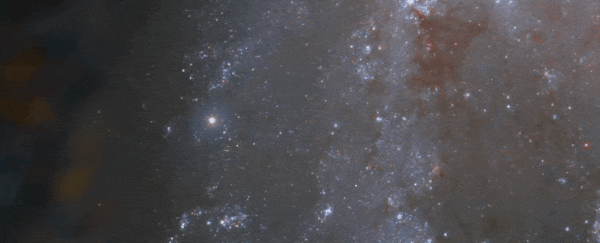With an uncountable number of stars in the Universe, you'd think their explosive deaths would be fairly common. However, rarely do we get to see the spectacular way these supernova events unfold in the visible spectrum - but that's exactly the treat the Hubble Space Telescope has given us today.
In January 2018, a bright explosion of light was spotted at the outskirts of a galaxy called NGC 2525, 70 million light-years away. In February of 2018, the Hubble Space Telescope turned its Wide Field Camera 3 in the flash's direction, and started taking pictures.
For an entire year, until February 2019, Hubble continued to take images of the progression of the supernova as it faded over time, until it was no longer visible.
The space telescope just missed the supernova's peak brightness of about 5 billion times the light of the Sun, but it was still gleaming extremely brightly when Hubble tuned in.
"No Earthly fireworks display can compete with this supernova, captured in its fading glory by the Hubble," said astrophysicist Adam Riess of the Space Telescope Science Institute and Johns Hopkins University.
The supernova event itself, named SN 2018gv, is more than just cosmic fireworks though - it's one of the tools astrophysicists and cosmologists are using to help figure out how fast the Universe is expanding.
It's what is known as a Type Ia supernova, which occurs when a white dwarf star in a binary pair siphons off so much material from its companion that it becomes unstable and explodes in a supernova. Because this critical mass - known as the Chandrasekhar mass - is within a known range, Type Ia supernovae have a determinable intrinsic brightness.
There is some variation in Type Ia supernova peak brightness, but it's related to how quickly the supernova fades, so observing this process closely allows scientists to be able to calculate the peak brightness with precision.
This makes them extremely valuable for gauging cosmic distances. If you know how intrinsically bright something is, you can calculate how far away it is. And if you can calculate how far away something is, you have a useful tool for probing the properties of the space around it.
For instance, distance measurements can affect how much dark matter we perceive a galaxy to have. They can tell us how bright galaxies are. And, of course, they're key to measuring the speed of expansion of the Universe, a number we can't seem to pin down, but that is fundamental to cosmology.
This is why Riess and his team - and many other astronomers around the world - are studying Type Ia supernovae like SN 2018gv.
Hubble Space Telescope observations like these are invaluable, and over the 30 years since it commenced operations, Hubble has greatly aided the efforts to narrow down the uncertainty in Type Ia supernovae distance measurements - and calculations of the Universe's expansion rate in turn.
The James Webb Space Telescope, when it launches, should be able to see Type Ia supernovae even farther across space. That will, of course, be great for science.
But we can't wait to see the timelapses.
